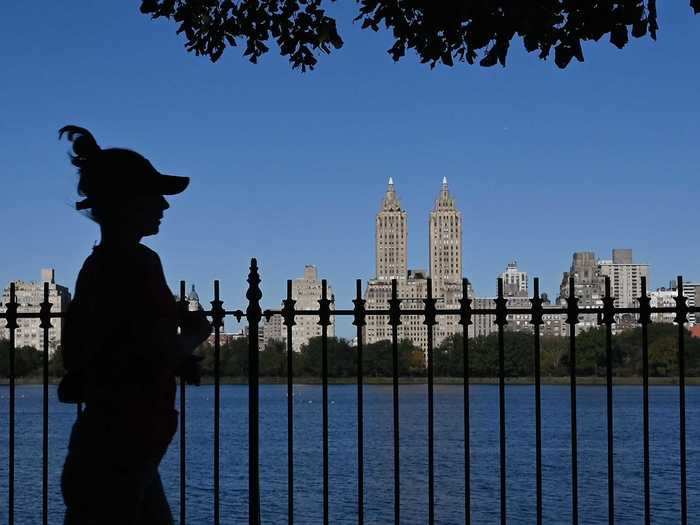
Central Park Hooverville with Central Park West in the Background in 1932.NY Daily News Archive via Getty Images
In the early 1930s, New York City's Central Park was home to a small shanty town that residents experiencing homelessness built.
The ramshackle town was a "Hooverville," named after Republican President Herbert Hoover. Americans held him responsible for not doing enough to alleviate the Great Depression.
Hoovervilles appeared all over the US in the 1930s, some with as many as 15,000 residents. Despite their dilapidated condition, reports highlight how those living in them did their best to keep their homes tidy, and themselves presentable.
One man told a New York Times reporter in 1931: "We work hard to keep it clean, because that is important. I never lived like this before."
The Hooverville in Central Park was not the largest, or around for the longest, but something about that small group of shacks surrounded by some of New York's most impressive, expensive buildings caught people's imagination.
As one New York Daily News caption put it: "From their windows, the 'Haves' may look on the humble houses of the 'Have Nots'."
Here's what Central Park's Hooverville was like.

Source: Vanity Fair

Source: The New York Times

These new towns were called "Hoovervilles," a term coined by Democratic National Committee publicist Charles Michelson. It was a politicized dig at Republican President Herbert Hoover, who many held responsible for not doing enough to alleviate the depression.
However, a New York Times article from November 1930 said residents of a Chicago shanty town first came up with the name "Hooverville".
The mayor of that Hooverville, a disabled former railman, told the Times: "Building construction may be a standstill elsewhere, but down here everything is booming."
Sources: The Atlantic, The New York Times, New York Magazine

Source: Vanity Fair

Sources: National Archives, Miller Center

Source: History.com

Source: New York Daily News, History.com

Source: New York Daily News, History.com

Sources: The New York Times, New York Daily News

Source: Politico

Sources: New York Daily News, The New York Times

One man told the reporter: "We work hard to keep it clean, because that is important. I never lived like this before."
According to The New York Times, those living in the Hooverville made "themselves look presentable and keep their shacks as clean as they can."
Source: The New York Times

At that point, US unemployment reached 25%. Across the US, about 2 million people roamed around looking for work.
Sources: The New York Times, New York Daily News, Smithsonian Magazine

Source: New York Daily News

Source: New York Daily News

McDermott later went to jail for six months for dancing and singing without wearing enough clothes.
Sources: The New York Times, New York Daily News

Source: The New York Times

"I never felt particularly afraid of these men in the 30's who, as I remember them, were decently dressed and not menacing," Jablons wrote.
"But it was one of the sights for the people living in the high-rise apartment houses on Riverside Drive or West End Avenue to take in on a Sunday stroll between 96th and 110th Streets."
Source: The New York Times

Sources: New York Daily News, The New York Times

Source: The New York Times

The New York Times wrote in 2007: "Moses reseeded lawns, planted flowers, repaved walks, transformed the old Croton Reservoir into the Great Lawn and built a necklace of public playgrounds along the edges of the park."
Sources: The New York Times, The New York Times

Overall though, homelessness in the US did fall between 2007 and 2019, except for a surge in California.
Sources: CNN, CNN, The New York Times, The Nation

They're meant to help with social distancing and to protect people experiencing homelessness from the coronavirus.
Source: Los Angeles Times

Source: The New York Times

Sources: CNN, The New York Times

Source: The New York Times
 Finance minister asks for greater push and investment in the manufacturing sector at the CII Annual Summit
Finance minister asks for greater push and investment in the manufacturing sector at the CII Annual Summit
 China plans to float nuclear reactors in disputed South China Sea; Analysts see it 'risky for environment'
China plans to float nuclear reactors in disputed South China Sea; Analysts see it 'risky for environment'
 ISRO announces plans to make India the third country to reach Mars, draws inspiration from NASA’s probes
ISRO announces plans to make India the third country to reach Mars, draws inspiration from NASA’s probes

Copyright © 2024. Times Internet Limited. All rights reserved.For reprint rights. Times Syndication Service.